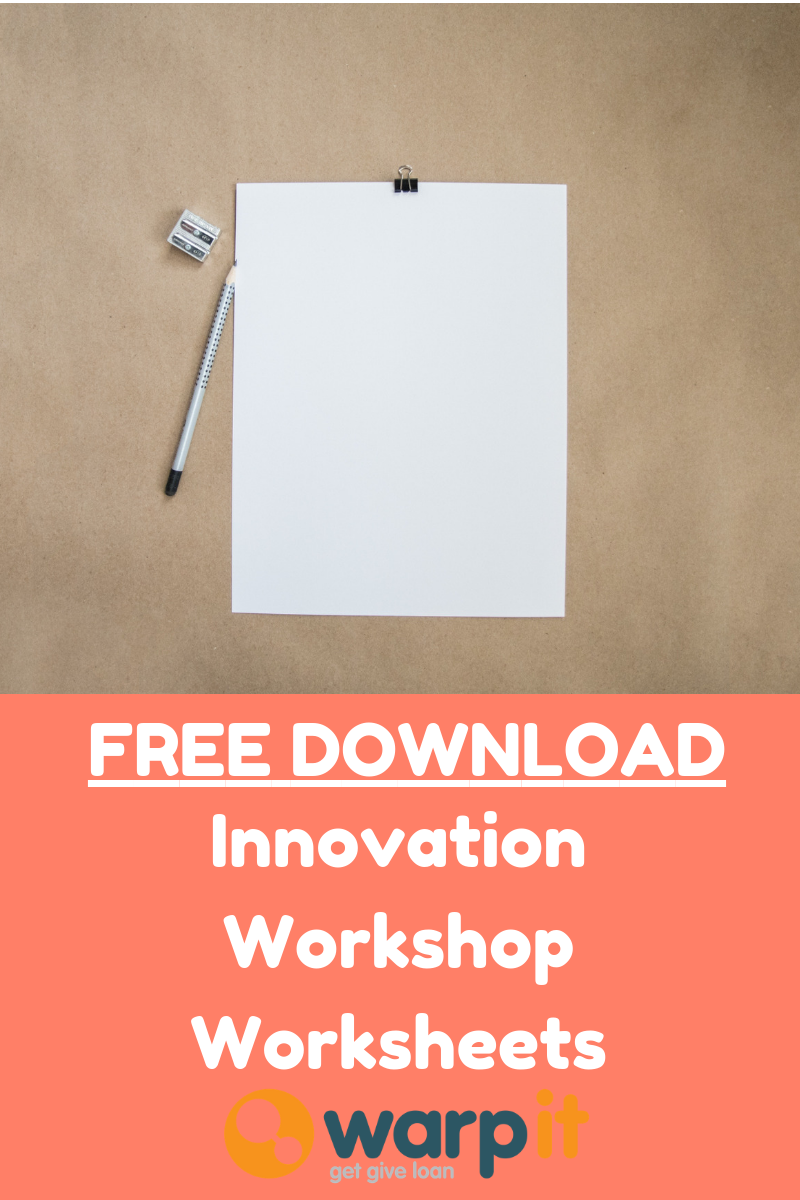A workshop is one of the most fun, intriguing, ambitious, and useful ideas for getting your main stakeholders to buy into your new idea, proposal, or project.
The only difference is, the solution is not yours, it belongs to everybody.
Here at Warp It, we’ve been trying to drive positive changes in organisations for many years now.
Throughout that time we’ve had successes, we've had failures, and we've had some so-so results.
From all of those experiences, we can safely say that we now know a little bit about delivering successful projects.
Last year we started the Warp It Customer Workshops right around the country to help us get better at what we do. Click here to see some video about the events. Part of the event was to run innovation sessions to stimulate ideas.
We've taken our experiences from those workshops and mashed them up into this blog post and guide.
I want change makers in organisations to consider innovation workshops as part of their toolkit for getting people on board to help solve organisational issues.
Why are you reading this guide?
I’m assuming that you’re reading this because you are someone who seeks progress, someone who wants their organisation to perform better, whether it’s in sustainability, project management, procurement, finance, or any other department.
The following advice and concept can be applied to any scenario, and since I know you’re adaptable and want to make a change, you’ll see the bigger picture as you continue.
At the end of this article, you will be given some tools to help support your mission and a framework for hosting your own innovation workshop.
Making a noticeable difference
You want to make a difference, have a positive impact, improve the organisation, and make things better for everyone involved. But, you need help. You need collaborators, supporters, champions, people to join you on your journey and push the ideas towards a successful end. If you want to make a noticeable difference you have to bring these people together and share ideas. That’s what the innovation workshop is for.
Ideas will bubble and brew
In the act of identifying and specifying a problem comprehensively, it is hoped that ideas will bubble to the surface and that at least one of those ideas will help to solve that problem. Since the whole group has then been involved in generating that idea, the group naturally has buy-in and wants to see that idea succeed.
Here’s how you do it.

Step One - What is the problem you want to solve?
Instead of presenting your ideas, present the problem that you want to solve.
You have your own ideas, and you want to present them to the stakeholders. You’re excited and you’re tempted, but you shouldn’t pitch your own ideas.
You need people to focus on the problem and come up with their own ideas to get buy in to fix the problem.
Use pictures, use creative language, use presentations, take people on a tour to see the problem in person. How you illustrate the problem is up to you, but don't give away your solution yet.
Step Two - Find out who the key stakeholders are for your problem and invite them to your workshop
Think of every problem like a theatre production. There is a general problem to be solved by the plot and a group of actors work together to resolve the problem, or against each other to stifle the solution, in order to reach the end of the play. Some people create the problem, some people are the problem, some people maintain the problem, some people offer distractions from the problem, and some people suffer at the hands of the problem. You need to figure out who is who, so invite a wide spectrum of people, open-minded, closed-minded, creatives, progressives, innovators, objectors, and laggards. The more diverse the better.
Step Three - Hosting a Workshop
At the start of your workshop, there are some things you need to explain, such as:
- What is the purpose of the workshop?
- How long is the workshop going to last for?
- How can people benefit individually and as a group from the session?
- That this is part one of a much longer journey of improvement
Ideally, your attendees will already know about the problem. You might have sent them a video, taken them on a tour, sent through some emails, or any of the other ideas from Step One. Start by asking:
- What is your point of view of the problem?
- Why does this problem occur?
- Who is involved?
- Where are the key locations?
- What are the impacts of the problem?
You need to consider a few things about the structure and layout of your innovation workshop:
- Will this be a lecture style event, with you talking to a crowd?
- Do I need break out space? (Yes)
- Can you break the event up into smaller groups for different dates?
- Can you split people up into teams of four with some documents prepared to direct their discussions? (Yes)
- Should you order coffee and buns (Yes!)
- Should I consider an outside agency to deliver the session/s or should we do it alone?
- Should we pick a date and time when everyone can show up? (YES- that means avoid Monday and Friday and keep the session to 1-2 hours either side of lunch)
- Should we tempt people to attend with a free lunch (Yes!)
Step Four - Beginning the discussion
The first exercise is to get your groups to express in their own words what the problem is, preferably on paper. Then the group shares what they’ve written on their paper and you start writing down the ideas. Give them a flip chart or a large piece of paper to start drawing out the processes and mistakes that have lead to the problem.
As the discussion begins, keep asking the groups to ask ‘why?’, again and again. The more you ask ‘why?’, the more precisely you define the problem. 'Why?' is just the starting point. They should also be asking ‘what?’, ‘where?’, ‘how?’, ‘which?’, and ‘when?’. The clearer and better defined the problem, the easier it’s going to be to find a solution.
If you have multiple groups, get each group to choose a volunteer as a representative and ask them to explain or draw the process with the other groups. Remind them that you don’t want to hear about solutions because there’s more to the problem than they’ve realised, and give them even more time to define the problem.
Step Five - Proposing solutions. X factor for innovation.
In the groups, ask them to brainstorm possible solutions to the problem, telling them that they have a ‘magic wand’ that means nothing is off limits. Tell them to get creative, break the laws of physics and finance, and open their minds to the potential ways to solve the problem.
You want people to think big to have a big impact. So remove financial and other barriers for now.
Depending on how many groups or people you have, you now want to bring your smaller groups together and to form a large group. The idea is now to start pitching the ideas to each other. You want the ideas that have the biggest impact and are the most practical, ignoring the hassle or expense involved.
You encourage the group discussion, asking everyone to discuss the different ideas that are flying around. Naturally, people are going to start supporting certain ideas, while other ideas drop out of the discussion. The best ideas are going to bubble up to the top, and because teamwork has generated these ideas, people are subconsciously bought in and supporting them. By the end, you’re probably going to be left with just a few good ideas, and so now it’s time to vote.
Give everybody who wants to pitch their idea the opportunity to do so. Everyone else will have a piece of paper on which they can vote for the best ones. Tell them that they can choose multiple options, as this allows people to get behind multiple projects.
You really want to come away from the session with a few good ideas that the group support. Because you are gong to have to do further exploration. So if you have 10 good ideas great. You take all of them forward to further consideration.
Step Six - The end of the Innovation Workshop
By the end of the session, hopefully, you’ve got more than one really good solution for solving the problem. Remember that the whole of the workshop is behind these ideas or at least some of them. You can get rid of the ideas that didn’t get any votes, and just look at the ones that have the most support. After the workshop you go away, you look at the solutions and you pick the one that is most feasible, and you begin building your implementation strategy. Keep all of the contact details for the attendees and regularly update them, every month ideally. Keeping them informed of which idea actually is going to work for the organisation the best and why.
Step Seven - Launching the solution
When you go to launch your initiative, you can follow Warp It’s buy-in program and use all of the attendees, say it’s 20, 40, 50, or 60 people, and you’re going to make them the focus of your pilot program, or a mini-pilot as we like to call it. These people are ambassadors, champions, and supporters even from before day one! They’re going to get these solutions embedded and try to fix the problem, because they’ve been engaged, listened to, and used to create the solution.
What you need to remember
Now, the caveat is this. You're at the start of this project and you might have an idea for how to fix this problem, but you’ve got to let that go. Don't let ego get in the way, you’ve got to give that problem to the crowd and let them solve it.
When the crowd solves the problem, the crowd have already bought into the solution.









